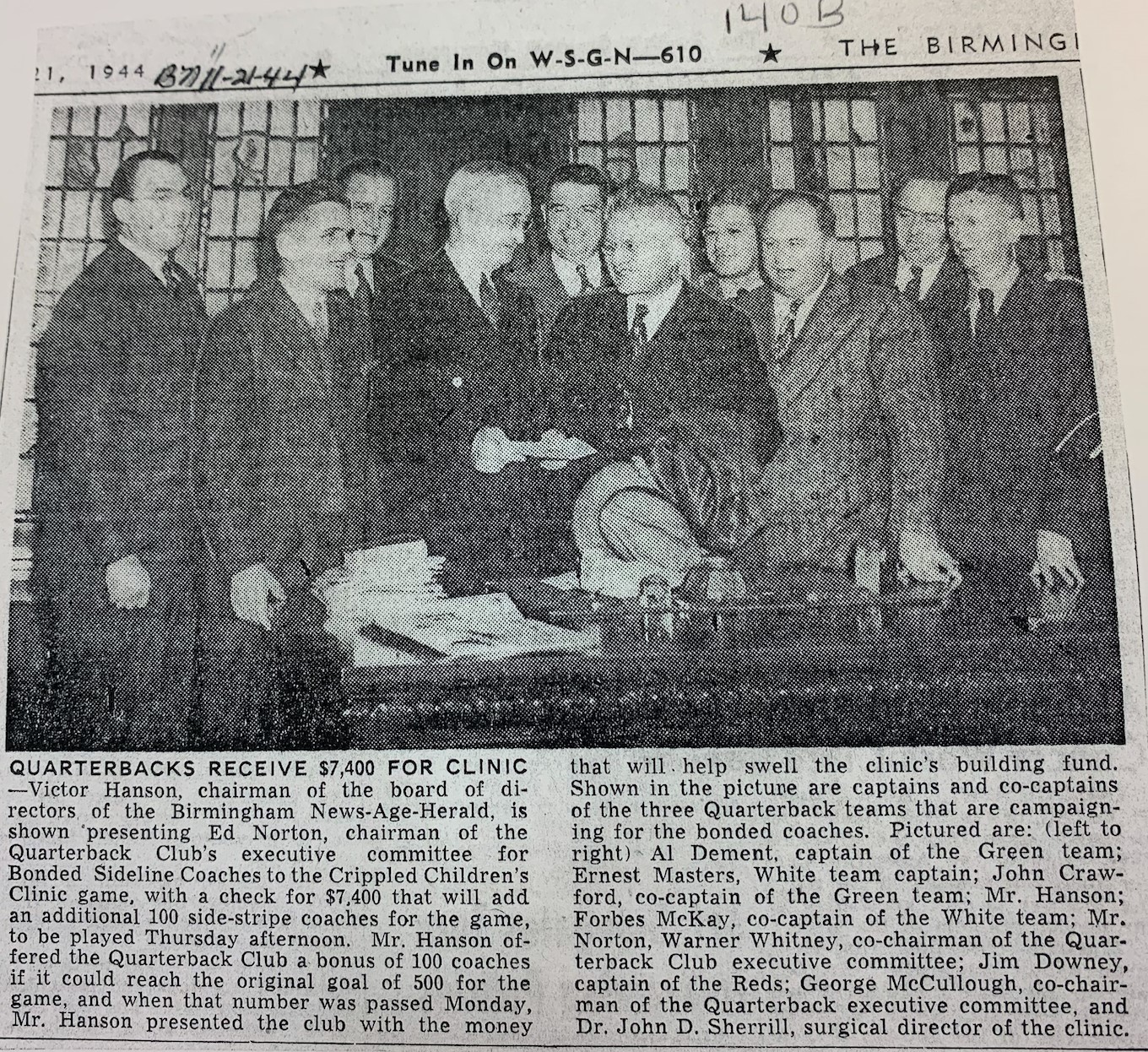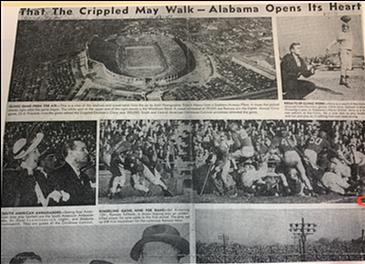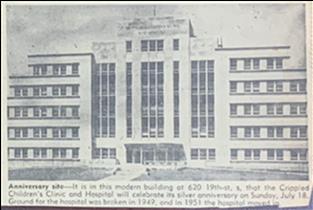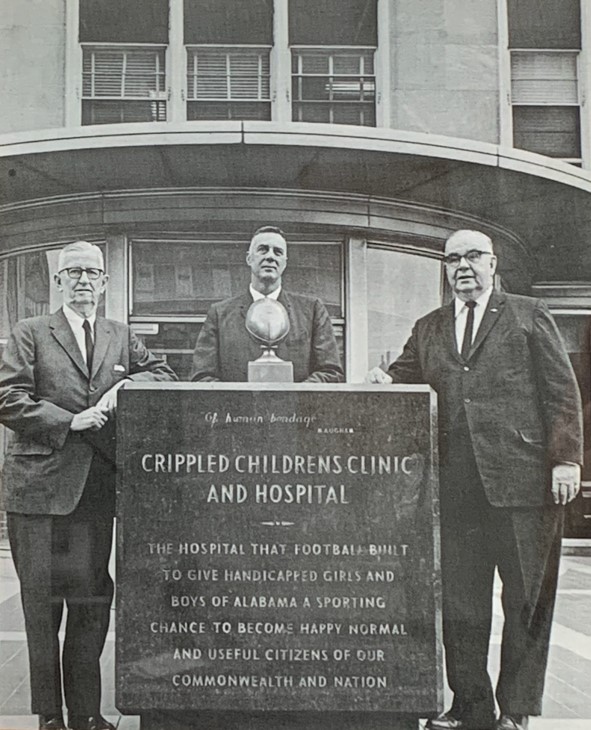 Dr. John D. Sherrill (right) meets with the Monday Morning Quarterback Club, 1944.Authors: David A. Patch, MD, Matthew C. Hess, MD, Michael D. Johnson, MD, Steven M. Theiss, MD
Dr. John D. Sherrill (right) meets with the Monday Morning Quarterback Club, 1944.Authors: David A. Patch, MD, Matthew C. Hess, MD, Michael D. Johnson, MD, Steven M. Theiss, MD
Not surprisingly, in a region where football and an appetite for charity have supported many initiatives, the history of the UAB Department of Orthopaedic Surgery and the orthopaedic surgery residency program has also benefitted from these forces. The story of the Department of Orthopaedic Surgery at the University of Alabama at Birmingham (UAB) and “The Hospital Football Built” are inseparable. This, combined with the vision and leadership of Dr. John Doke Sherrill, paved the way for generations of orthopaedic excellence.
Dr. John D. Sherrill was born in Hartselle, Alabama in 1892. After finishing the two-year curriculum at the Birmingham Medical College in 1915 (BMC’s last class), he practiced briefly with his father in Hartselle, AL before entering WWI. After the war, Dr. Sherrill returned to Birmingham where he pioneered the specialty of orthopaedic surgery, his passion.
His commitment to selfless ideals would lead to his appointment as the first UAB Chief of Orthopaedic Surgery. Dr. Sherrill also served as the first orthopaedist for the University of Alabama’s football team before becoming the Surgical Director of the Crippled Children’s Clinic and Hospital (1934-1968) where he rendered care to children during the poliomyelitis “polio” epidemic. Dr. Sherrill was instrumental in helping to build the Cripple Children’s Hospital in the UAB Medical Center for young polio patients along with the help of donations from organizations including the Monday Morning Quarterback Club and from citizens in the community.
The onset of the United States polio epidemic began between the late 19th-early 20th century, triggering widespread fear of its paralytic potential across the country. In Birmingham, one of the most enduring relief efforts began with a small group of driven individuals at 630 North 19th Street, who opened the first Crippled Children’s Clinic there. However, the clinic quickly became overwhelmed with hundreds of applications for affected children. In response, a fundraising campaign referred to as the “365 Club” requiring only $3.65 a year (one cent a day) stepped up to help. While these efforts were paramount in sustainability, the need for services for affected children continued to grow and in 1936 the clinic was relocated to 11th Avenue and 25th Street North which for the first time offered 40 beds with multidisciplinary services, including operating rooms, a swimming pool, x-ray equipment, hydrotherapy, and several iron lungs. As the epidemic unfolded, it became apparent that the game of football offered hope for the children of Alabama and their families. In the early 1930s, Dr. Sherrill helped originate a series of high school football games launched at Legion Field to benefit the Crippled Children’s Clinic. Those early benefit games transformed into larger contests between freshman teams from universities including Birmingham-Southern College, Samford, and Auburn to support the Children’s Clinic.
However, as the polio pandemic grew and surrounding counties relied on the clinic for support, needs quickly exceeded the capacity of the clinic- at one point 9,000 children with polio in Alabama were on the waitlist to be seen. Meanwhile, a sports editor of The Birmingham News, Henry Hardin “Zipp” Newman, had a vision of combining his love of football with supporting the fight against polio. In 1939, he would go on to establish the “Monday Morning Quarterback Club” to unite local football fans and help provide funding for the Crippled Children’s Clinic. What started as a gathering for fellowship among football lovers quickly grew into one of the most generous civic clubs in the country, drawing support from legendary college football coaches. Club members were instrumental in establishing the foundation of Alabama’s Children’s Hospital.
 Annual Crippled Children’s Clinic football game. In 1941 the club sponsored and organized the first Crippled Children’s Clinic Game. This game was an annual high school football game that raised money for the Crippled Children’s Hospital to render care for children struck with polio. Later on, in 1943, the event was moved to Thanksgiving Day and specifically reserved for a high school championship game at Legion Field, featuring the top two teams in Birmingham. Polio patients themselves would often come to cheer on the high school athletes in the championship game. It became evident that the determination demonstrated on the gridiron was making a difference in the lives of young polio patients. By 1951 a new $3 million 100-bed Crippled Children’s Clinic and Hospital was opened at 620 South 19th Street. Its unique “wedding cake” appearance enabled children to sunbathe on the patios and included a state of-the-art polio ward. On Thanksgiving Day of 1951, a monument placed outside of the building was dedicated to the Quarterback Club and read “The Hospital Football Built."
Annual Crippled Children’s Clinic football game. In 1941 the club sponsored and organized the first Crippled Children’s Clinic Game. This game was an annual high school football game that raised money for the Crippled Children’s Hospital to render care for children struck with polio. Later on, in 1943, the event was moved to Thanksgiving Day and specifically reserved for a high school championship game at Legion Field, featuring the top two teams in Birmingham. Polio patients themselves would often come to cheer on the high school athletes in the championship game. It became evident that the determination demonstrated on the gridiron was making a difference in the lives of young polio patients. By 1951 a new $3 million 100-bed Crippled Children’s Clinic and Hospital was opened at 620 South 19th Street. Its unique “wedding cake” appearance enabled children to sunbathe on the patios and included a state of-the-art polio ward. On Thanksgiving Day of 1951, a monument placed outside of the building was dedicated to the Quarterback Club and read “The Hospital Football Built."
 Crippled Children’s Clinic and Hospital. Under the leadership of Dr. Sherrill, the Crippled Children’s Hospital served the Birmingham community for over 20 years helping polio patients transition back into their daily lives. Once the disease was largely eradicated in late 1960’s the hospital became repurposed and in 1969 became part of the University of Alabama at Birmingham. The Crippled Children’s Foundation was later formed which continues its mission in fighting childhood diseases today. Though the original “Hospital Football Built” has since been torn down and UAB’s Spain-Wallace Building now stands in its place, the spirit of its presence remains. Since that time, over $29 million has been contributed by the club and the Crippled Children’s Foundation to charitable organizations.
Crippled Children’s Clinic and Hospital. Under the leadership of Dr. Sherrill, the Crippled Children’s Hospital served the Birmingham community for over 20 years helping polio patients transition back into their daily lives. Once the disease was largely eradicated in late 1960’s the hospital became repurposed and in 1969 became part of the University of Alabama at Birmingham. The Crippled Children’s Foundation was later formed which continues its mission in fighting childhood diseases today. Though the original “Hospital Football Built” has since been torn down and UAB’s Spain-Wallace Building now stands in its place, the spirit of its presence remains. Since that time, over $29 million has been contributed by the club and the Crippled Children’s Foundation to charitable organizations.
Throughout its history, UAB orthopaedic surgery has had the benefit of strong leaders. Beginning with Dr. Sherrill, each leader of orthopaedic surgery, whether acting as Chief of Orthopaedic Surgery, Division Director of Orthopaedic Surgery, or ultimately Chairman of the Department of Orthopaedic Surgery, put their indelible mark on the growth and development of the orthopaedic program. The roster of the leaders of orthopaedic surgery is as follows:
Leaders of UAB Orthopaedic Surgery:
Chestley L. Yelton, MD 1963-1974
Kurt M. W. Niemann, MD 1974-1989
Victoria R. Masear, MD 1990-1994
John M. Cuckler, MD 1994-2004
Thomas R. Hunt, MD 2004-2012
Steven M. Theiss, MD 2013-present
The growth and development of orthopaedic surgery at UAB ultimately culminated in 2017 with it being elevated to Department status, becoming the 27th department at UAB. This designation not only recognized the maturation of the program, but also gave UAB Orthopaedic Surgery the resources needed to grow their clinical, education and research programs.
History of the UAB Department of Orthopaedic Surgery Residency
 “The Hospital Football Built” monument. John D. Sherrill, MD (left). The orthopaedic surgery residency program started in the late 1940s. Ralph J.W. Hobbs, MD of Edenton, NC, was the first resident and later joined Dr. Sherrill in practice. There were several other notable residents during the early years of the program. These were notable not only for their distinguished careers in the Birmingham area, but also because of their historical family ties to orthopaedic surgery at UAB. These included Dr. Benjamin Meyer who was the second resident, and practiced most of his life at Carraway Methodist Hospital in Birmingham. Dr. John D. Sherrill, Jr., trained as a resident in the early 1950s, as the second member of the Sherrill family to be affiliated with UAB, joined his father’s practice and followed him as an orthopaedist for the University of Alabama football team. Finally, Dr. Joe Sherrill, Dr. John’s grandson, also finished the UAB orthopaedic residency in 1980 and practices orthopaedic and hand surgery in the Birmingham area. Dr. Richard Meyer, son of Dr. Benjamin Meyer, also finished his orthopaedic residency in 1976 and is on the orthopaedic surgery staff at UAB.
“The Hospital Football Built” monument. John D. Sherrill, MD (left). The orthopaedic surgery residency program started in the late 1940s. Ralph J.W. Hobbs, MD of Edenton, NC, was the first resident and later joined Dr. Sherrill in practice. There were several other notable residents during the early years of the program. These were notable not only for their distinguished careers in the Birmingham area, but also because of their historical family ties to orthopaedic surgery at UAB. These included Dr. Benjamin Meyer who was the second resident, and practiced most of his life at Carraway Methodist Hospital in Birmingham. Dr. John D. Sherrill, Jr., trained as a resident in the early 1950s, as the second member of the Sherrill family to be affiliated with UAB, joined his father’s practice and followed him as an orthopaedist for the University of Alabama football team. Finally, Dr. Joe Sherrill, Dr. John’s grandson, also finished the UAB orthopaedic residency in 1980 and practices orthopaedic and hand surgery in the Birmingham area. Dr. Richard Meyer, son of Dr. Benjamin Meyer, also finished his orthopaedic residency in 1976 and is on the orthopaedic surgery staff at UAB.
During the late 1960s and early 70s the orthopaedic residency program covered several hospitals including the University of Alabama at Birmingham, Birmingham Veteran Affairs Hospital, Children’s, the Cripple Children’s Service, Cooper Green, and Lloyd Nolan Hospital in Fairfield, AL. The orthopaedic residency at Lloyd Nolan Hospital in Birmingham was absorbed into the UAB program in 1971, which opened the UAB Orthopaedic Surgery residency to four residents each year in the four-year program. Ultimately, in 2004 under the leadership of Dr. Thomas Hunt, and Dr. David Volgas, the orthopaedic residency program increased the number of residents to six per year in the five-year program. This represents the current compliment of resident positions today. The present makeup of the program, including the service rotations, can be viewed here.